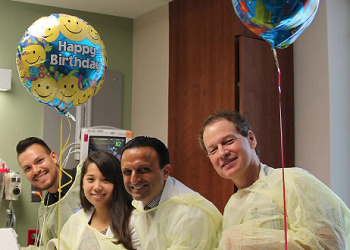Dealing with postpartum hair loss
Experiencing shedding, thinning or hair loss is common postpartum. Once baby and placenta are delivered, pregnancy hormones (estrogen and progesterone) decrease, signaling the body that pregnancy is over. It can take about 15 months for hormones and hair growth to return back to normal.
 “Things start to change when you initiate breastfeeding, but the physiological changes of pregnancy encourage hair to stay in the growing phase longer than it normally would,” said Dr. Matthew Carroll, assistant professor of obstetrics and gynecology at Baylor College of Medicine.
“Things start to change when you initiate breastfeeding, but the physiological changes of pregnancy encourage hair to stay in the growing phase longer than it normally would,” said Dr. Matthew Carroll, assistant professor of obstetrics and gynecology at Baylor College of Medicine.
Hair often gets thicker during pregnancy, so most pregnant women will see an increase in shedding postpartum due to a condition called Telogen effluvium, which can also occur with chronic stress or nutritional deficiencies. With Telogen effluvium, all the hairs that were stuck in the growing phase catch up and go back to the resting phase, which is when the hair falls out and thins.
Minoxidil, also known as Rogaine over the counter, is a hair loss treatment that encourages hair follicles to go into the growing phase. According to Carroll, there is mixed data on whether it helps with postpartum hair loss, but it is a low-risk treatment.
“Hair loss can have a significant impact on well-being. It’s important to many how they present themselves, and it can add stress to the postpartum period. Having this option that is not harmful is something we can discuss with patients,” Carroll said.
The most promising supplement for people with low keratin counts is to continue iron supplementation, even if you don’t have signs of iron deficiency or anemia. Other supplements, such as biotin, vitamin D or zinc don’t typically help with hair growth during the postpartum period.
Continue your normal hair routine and avoid harsh treatments on the hair, as well as anything that could increase shedding. If hair loss is impacting your well-being, there are different ways to get support for your situation. Ask for guidance from your OBGYN or a mental health specialist. A hair stylist can also give advice on different hairstyles that can cover up areas of thinning to promote self-image and well-being.
Women who have female-pattern baldness, alopecia or any medical condition leading to hair loss might continue their hair treatments or hold off during pregnancy, depending on what their doctor tells them. Taking an oral formulation of Minoxidil during pregnancy is not recommended.
While many experience hair loss on the head, androgen hormone-driven growth can increase in pregnancy with hair appearing on other parts of the body, such as the feet or stomach area. If those hair follicles develop, it often subsides postpartum.
“Even though some people think postpartum hair loss is a minor thing, there is a really impactful physiological effect, and we need to be supportive and respectful of what people are going through,” Carroll said.
By Homa Shalchi



